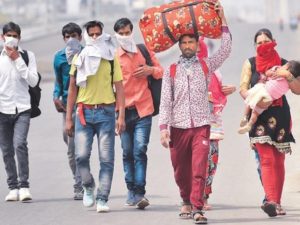
Indian migrant workers during the COVID-19 pandemic have confronted various difficulties. With industrial facilities and work environments shut down because of the lockdown forced in the nation, a large number of migrant labourers needed to manage the loss of pay, food deficiencies and vulnerability about their future. Following this, a considerable lot of them and their families went hungry. Thousands of them at that point started strolling back home, without any methods for transport because of the lockdown. Accordingly, the Central and State Governments took different measures to support them and later organized vehicle for them. More than 300 migrant labourers kicked the bucket because of the lockdown, with reasons running from starvation, suicides, weariness, street and rail mishaps, police mercilessness and refusal of ideal clinical consideration.
There are an expected 139 million migrants in the nation, as indicated by the World Economic Forum. The International Labor Organization (ILO) anticipated that because of the pandemic and the lockdown, around 400 million workers would be destitution stricken. Most migrants in the nation starting from Uttar Pradesh and Bihar, trailed by Rajasthan and Madhya Pradesh. The urban communities of Mumbai and Delhi pull in the most noteworthy number of migrants. While most men relocate for work, ladies move because of marriage.
Migrant workers significantly include day by day wage workers working in the assembling and development enterprises. They are regularly denied sufficient social insurance, nourishment, lodging and sanitation since a large number of them work in the casual sector. They are for the most part from rustic territories however live in urban communities for work for the greater part of the year. Many have no reserve funds and lived in industrial facility quarters, which were closed because of the lockdown. Moreover, there was no focal library of migrant labourers, regardless of the presence of the Inter-State Migrant Workmen Act, 1979.
As per research distributed in the Royal Geographical Society, the labourers who have been dealt with the most noticeably awful are from territories like Odisha, Jharkhand and Chhattisgarh, in which the indigenous populace’s regular assets were extricated by outcasts. Further, labourers paid the least for the hardest work has a place with the retrogressive classes, primarily from the Dalit and the Adivasi people group. The examination additionally showed that the groups of the migrant labourers bolstered them by keeping up their homes and dealing with them, either when occasional work is inaccessible or when they are not, at this point ready to work.
Maharashtra has the biggest number of migrants, as per the 2011 Census of India. Its state government forced a lockdown on 20 March in Pune, Pimpri-Chinchwad, the Mumbai Metropolitan Region and Nagpur, leaving the migrant workers with no work. Thousands at that point assembled at the train ends and transport stations, looking for transport to the places where they grew up. With the across the nation lockdown, all vehicle offices were shut.
As indicated by government reports, there was sufficient food grain loaded up in the FCI godowns to take care of the poor for in any event a year-and-a-half. While the government plans guarantee that the poor would get extra apportions because of the lockdown, the appropriation framework neglected to be viable as the proportion cards are zone explicit and reasonable value shops were generally out of reach.
Moreover, the ‘One Nation, One Ration Card’ framework has been actualized in not very many states, as of mid-April. While the plan permitted migrant workers to recover foodgrains for nothing anyplace the nation over, not many knew about the plan. Furthermore, the plan likewise required biometric validation, which was suspended because of fears of spreading the infection through regular unique mark sensors. In Telangana, many couldn’t profit off the apportion because of an absence of Aadhaar cards. In that capacity, many were left without food and cash because of the lockdown.
With no work and no cash, and lockdown limitations ending open vehicle, a huge number of migrant workers were seen strolling or bicycling many kilometres (or much more than a thousand kilometres) to return to their local towns, some with their families. Many did as such while hungry. Social separating was unrealistic for these migrants since they voyaged together in enormous groups. According to some of them, they would prefer to bite the dust from the infection in their own town than keep because from no work in the city.
Many were captured for disregarding the lockdown, in the wake of being gotten at between state outskirts, timberlands among states and even on pontoons to cross waterways. A portion of the migrants kicked the bucket of depletion. Others kicked the bucket in mishaps on the streets in the wake of strolling or covering up in vehicles. On 31 March, upwards of 120 migrant workers were purportedly thrashed by the police in Gujarat and strongly gathered together in a solitary lorry and dropped in Maharashtra, despite being injured. In Aurangabad, 16 migrants were slaughtered on 8 May after a cargo train ran over them while they were dozing on the tracks, depleted from walking.26 migrants were executed in a mishap between two trucks conveying migrants in Auraiya on 16 May. Later in May, a 15-year-old young lady conveyed her weak dad on a bike for 1,200 kilometres (750 mi) from Bihar to Gurugram through the span of seven days. She was later drawn nearer to go for the National Cycling Academy by the Cycling Federation of India and got acclaim from Ivanka Trump.
Later in May, regardless of the starting of extraordinary trains and transports by the administration, the migrant labourers decided to either travel together in enormous gatherings in the payload compartments of trucks and holders or travel by foot. They didn’t pause or their chance to board the legislature orchestrated vehicle, mostly because of starvation. Moreover, they felt that returning to the places where they grew up, they could come back to cultivating and take up little occupations under the MGNREGA.
The utilization of versatile and broadband information under BharatNet dramatically increased in provincial areas. On 1 May, the focal government allowed the Indian Railways to dispatch “Shramik Special” trains for the migrant labourers and others stranded. On 3 May, the Ministry of Home Affairs gently censured the state governments for briskly mentioning for trains to ship migrants, expressing that the trains were basically, for the most part, implied for the individuals who were abandoned because of the abrupt lockdown, and not the migrants. Additionally, this administration was not free, with extra charges over the typical admissions. The focal government at that point confronted analysis from the resistance, with the Indian National Congress promising to support the tickets of the migrants on 4 May. The administration at that point reported that the Railways would offer an 85% endowment on the train tolls, with the state governments financing the staying 15%. In any case, the migrants were as yet compelled to pay an undisclosed sum now and again. The focal government at first declined to share the insights about this with the Supreme Court, however, later affirmed that it was not paying for anybody’s toll. Furthermore, the focal governments mandate concerning which states should pay for the migrants’ movement brought about the difference between Maharashtra and different states.
A couple of days after the Shramik Special trains were presented, the Karnataka government dropped the trains (supposedly supporting the development business) and the Bihar government did likewise to trains originating from Kerala (declining to give a No-Objection Certificate). The two states later returned their choices.
Further, migrants confronted numerous difficulties while going by these trains. Many answered to have no food and water organized them while they travelled. A train from Goa to Manipur revealed a 58-hour delay, no legitimate food or sanitation offices on the train, and stone-pelting. Others who got food parcels and water detailed that the arrangements were essentially dumped at the passageways, leaving labourers battling with one another for their offer. A few migrants additionally kicked the bucket during the train ventures, however, the Railways expressed that a large portion of them had existing diseases. As indicated by Railway Protection Force, there have been just about 80 passings on board the Shramik Special trains somewhere in the range of 9 and 27 May.
Half of the mentors changed over into COVID-19 consideration places were utilized for these trains. According to a report given by the Indian Railways on 23 May, migrant workers from Bihar and Uttar Pradesh involved 80% of the train voyagers. Also, it was normal that 36 lakh migrants would go in the ten days after the report. 4,277 Shramik Special trains had moved around 60 lakh individuals, starting at 12 June.
Courtesy : Syed Mohd Zeeshan @Just life

